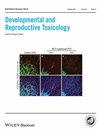胚胎-胎儿发育毒性研究中致畸严重程度的数值估计。
Q Environmental Science
Birth defects research. Part B, Developmental and reproductive toxicology
Pub Date : 2016-02-01
DOI:10.1002/bdrb.21171
引用次数: 10
摘要
暴露于有毒物质的发育中的生物体将产生从无到严重(即死亡或畸形)的反应。在给定剂量下的反应可能被称为致畸(或发育毒性)严重程度,并取决于暴露条件。在啮齿动物和兔子中进行的产前/胚胎-胎儿发育(EFD)毒性研究是对致畸严重程度的最一致和最明确的评估,而致畸筛选试验是根据其结果进行验证的最佳方法。一个公式提出了估计致畸严重程度的每一组,包括对照组,在一个EFD研究。发育成分包括胚胎/胎儿死亡、畸形、变异和平均胎儿体重。母体毒性的贡献包括乘法因子,以调整死亡率的程度,母体体重的变化,以及其他被认为重要的参数。描述了计算致畸严重程度公式的推导。从文献中提出了各种EFD数据集,以突出对公式的各个组成部分的计算的考虑。将每个评分与同期对照组进行比较,以获得相对致畸严重程度。有限的研究表明,相对评分高于对照组2至5倍的患者致畸严重程度可检测到,但水平较低,而相对评分高于对照组≥5倍的患者致畸程度越来越严重。这样的评分可能有助于完善基于暴露的验证列表的概念,以供筛选试验的支持者(Daston等人,2014)通过估计“阳性”暴露的严重程度,或在其他情况下通过定义LOAEL(最低观察到的不良反应水平)的严重程度来使用。本文章由计算机程序翻译,如有差异,请以英文原文为准。
Numeric Estimates of Teratogenic Severity from Embryo-Fetal Developmental Toxicity Studies.
A developing organism exposed to a toxicant will have a response that ranges from none to severe (i.e., death or malformation). The response at a given dosage may be termed teratogenic (or developmental toxic) severity and is dependent on exposure conditions. Prenatal/embryo-fetal developmental (EFD) toxicity studies in rodents and rabbits are the most consistent and definitive assessments of teratogenic severity, and teratogenesis screening assays are best validated against their results. A formula is presented that estimates teratogenic severity for each group, including control, within an EFD study. The developmental components include embryonic/fetal death, malformations, variations, and mean fetal weight. The contribution of maternal toxicity is included with multiplication factors to adjust for the extent of mortality, maternal body weight change, and other parameters deemed important. The derivation of the formula to calculate teratogenic severity is described. Various EFD data sets from the literature are presented to highlight considerations to the calculation of the various components of the formula. Each score is compared to the concurrent control group to obtain a relative teratogenic severity. The limited studies presented suggest relative scores of two- to
求助全文
通过发布文献求助,成功后即可免费获取论文全文。
去求助
来源期刊
CiteScore
1.65
自引率
0.00%
发文量
0
审稿时长
>12 weeks
期刊介绍:
The purpose of this journal is to publish original contributions describing the toxicity of chemicals to developing organisms and the process of reproduction. The scope of the journal will inlcude: • toxicity of new chemical entities and biotechnology derived products to developing organismal systems; • toxicity of these and other xenobiotic agents to reproductive function; • multi-generation studies; • endocrine-mediated toxicity, particularly for endpoints that are relevant to development and reproduction; • novel protocols for evaluating developmental and reproductive toxicity; Part B: Developmental and Reproductive Toxicology , formerly published as Teratogenesis, Carcinogenesis and Mutagenesis
联系我们:info@booksci.cn
Book学术提供免费学术资源搜索服务,方便国内外学者检索中英文文献。致力于提供最便捷和优质的服务体验。
Copyright © 2023 布克学术 All rights reserved.
京ICP备2023020795号-1
 京公网安备 11010802042870号
京公网安备 11010802042870号
京ICP备2023020795号-1

Book学术文献互助群
群 号:604180095


 求助内容:
求助内容: 应助结果提醒方式:
应助结果提醒方式:
